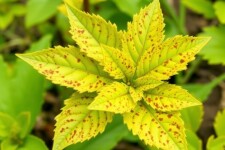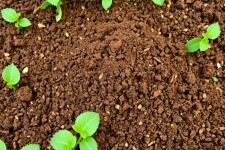If you live in a city apartment with a balcony, have a postage-stamp backyard, or simply want fruit trees that fit into a cozy courtyard, dwarf fruit trees are your best friends. These compact trees pack the sweet reward of homegrown apples, peaches, figs, and citrus into spaces where a full-size orchard would be impossible. In this article I’ll walk you through everything you need to know—what dwarf fruit trees are, how they’ve been bred, how to pick the right ones for your climate and space, how to plant and care for them (whether in a pot or in the ground), pruning and training techniques, pollination tips, pest management, and creative ideas for placing them around your home. Expect practical steps, clear examples, and inspiration that will make the idea of growing fruit in tight quarters feel totally achievable.
What exactly are dwarf fruit trees?
Dwarf fruit trees are varieties of fruit trees that stay smaller than their standard counterparts. That smallness comes from a few different sources: naturally compact cultivars, dwarfing rootstocks used in grafting, or careful pruning and training. The result is a tree with a smaller mature height and spread, often producing fruit much sooner than a standard tree and usually easier to manage for pruning and harvesting.
Why choose a dwarf tree? They are space-efficient, quicker to yield fruit, easier to harvest, fit in containers or narrow garden beds, and are often ideal for beginners. They aren’t stunt versions of full-size trees; most dwarf trees are fully fertile and produce fruit of the same quality as standard trees. The trade-off is typically lower total yield per tree, but by multiplying trees in containers or planting several varieties in a small area, you can still gather plenty of fruit.
How rootstocks and grafting determine size
Most fruit trees are grafted: a desirable fruiting variety (the scion) is joined to a rootstock chosen for traits like disease resistance or size control. Dwarfing rootstocks limit how large the tree grows. For example, apple rootstocks are labelled by codes like M.9 or MM.111; M.9 produces very small trees, MM.111 yields semi-dwarf trees. Learning a few rootstock names for the fruit you want will help you pick the right size. When buying, ask the nursery which rootstock was used—this determines mature size, winter hardiness, and whether the tree needs staking.
Which dwarf fruit trees work best for small spaces?
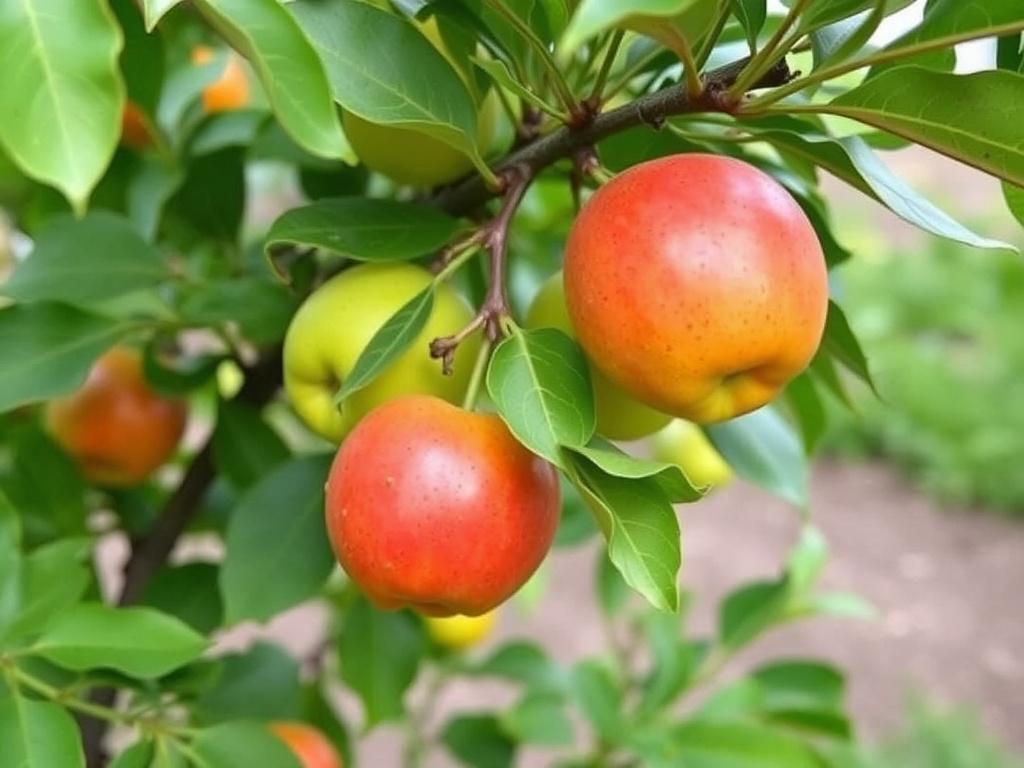
You can grow many types of fruit as dwarf trees. Some are more naturally suited to containers or narrow plots than others. Here are common options and why they’re good choices:
- Apple: Excellent for espaliers and containers; many dwarfing rootstocks available.
- Pear: Good for small gardens; some varieties are self-fertile.
- Plum: Compact varieties exist and are productive on dwarfing rootstocks.
- Peach and nectarine: Often trained as small trees; need more sun but reward you quickly.
- Cherry: Dwarfing cherries are available and fit well on balconies or against walls.
- Citrus (lemon, lime, orange): Naturally small and excellent in pots, especially indoors in cool climates.
- Fig: Compact habit and prolific fruiting; many varieties do well in large containers.
- Pomegranate: Compact, drought-tolerant, and ornamental as well as edible.
- Mulberry and persimmon: Dwarf cultivars are available for smaller plots.
Quick reference table: common dwarf fruit trees and their traits
| Fruit | Mature Height (approx.) | Suitable for Containers? | Pollination Notes | Best For |
|---|---|---|---|---|
| Apple (dwarf) | 1.8–3.5 m (6–12 ft) | Yes | Many require another apple variety for cross-pollination | Espaliers, small yards, patios |
| Pear (dwarf) | 2–3.5 m (7–12 ft) | Yes | Some are self-fertile, but many benefit from another pear | Small gardens, cool climates |
| Plum (dwarf) | 1.8–3 m (6–10 ft) | Yes | Variety-dependent | Containers, compact yards |
| Citrus | 1–3 m (3–10 ft) | Excellent | Many are self-fertile | Balconies, patios, indoor sunrooms |
| Fig | 1.5–3 m (5–10 ft) | Yes | Self-fertile | Containers, sheltered walls |
| Pomegranate | 1.5–3 m (5–10 ft) | Yes | Mostly self-fertile | Dry climates, patio gardens |
Choosing the right variety for your climate and space
Before you buy, consider these main questions: What climate zone are you in? How much sun does your spot get? Will the tree be in a pot or the ground? Do you want early fruiting or a tree that flowers abundantly? Here’s how to decide.
- Climate/Zone: Check the winter hardiness of the rootstock and cultivar. Apples and pears tolerate cold better than citrus, which needs warmth or indoor shelter in winter.
- Sunlight: Most fruit trees want at least 6–8 hours of sun. Less sun means fewer flowers and smaller harvests; some figs and pears tolerate light shade better than peaches or cherries.
- Space: Measure the available height and width. Espaliers and cordons let you fit fruiting wood into a narrow alley or wall.
- Pollination: Determine whether the tree is self-fertile. If not, can you accommodate another variety nearby or graft a second variety onto the same rootstock?
- Containers vs ground: If planting in a pot, choose a compact variety and be prepared for more frequent watering and feeding.
Recommended cultivars by situation
- Urban balcony (pots): Dwarf lemon ‘Improved Meyer’, apple ‘Garden Delicious’ on M.9, fig ‘Brown Turkey’.
- Small courtyard (in-ground or large pots): Dwarf apple ‘Buckeye Gala’, pear ‘Conference’ (compact), plum ‘Opal’.
- Warm Mediterranean climates: Dwarf pomegranate ‘Nana’, fig ‘Conadria’, dwarf citrus cultivars.
- Cold climates with short seasons: Dwarf apple varieties that fruit early, and tart cherries that tolerate chill.
Planting dwarf fruit trees: a step-by-step guide
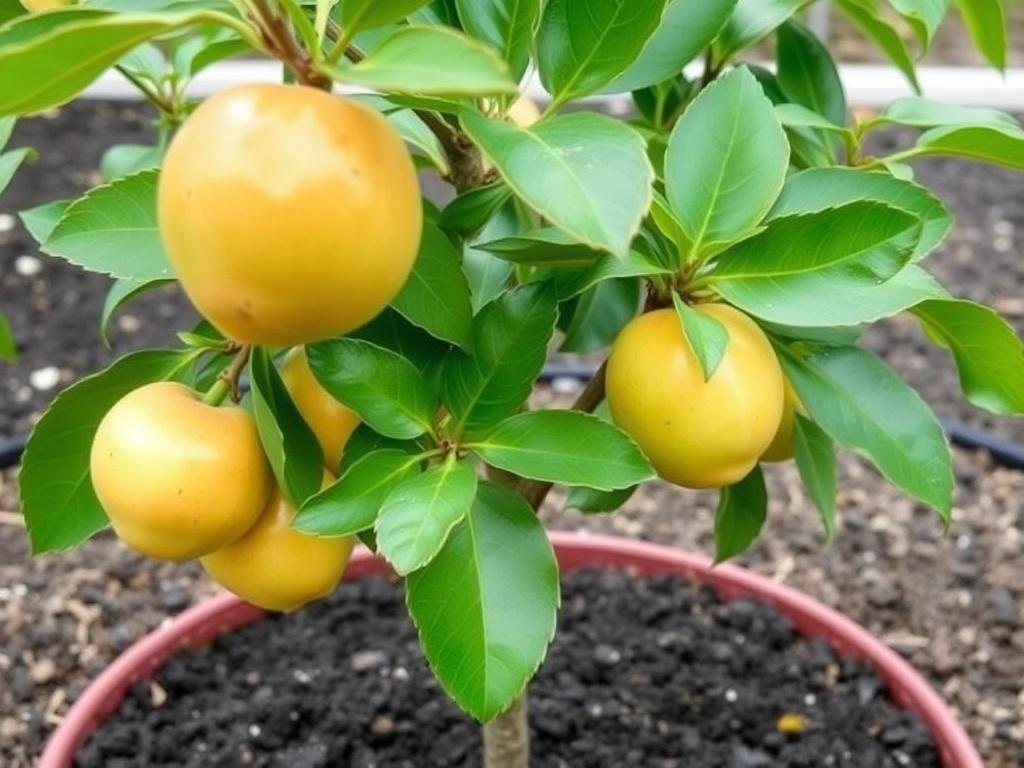
Planting is simple if you follow the basics. Whether you’re putting a tree in a container or the ground, these steps will set you up for success.
- Choose a healthy tree: Look for a tree with a straight trunk, a well-developed root system if container-grown, or wrinkle-free buds if bare-root. Avoid trees that look root-bound or overly pot-bound unless you plan to re-pot carefully.
- Pick the right location: Full sun is ideal. Ensure good air circulation to reduce disease. For containers, choose a spot with sufficient light and easy access for watering.
- Prepare the soil or potting mix: For in-ground planting, loosen the soil and amend with compost to improve drainage and fertility. For containers, use a high-quality potting mix with good drainage and organic matter.
- Dig the hole or pick the pot: Hole should be twice as wide as the root ball and just deep enough so the graft union sits a few inches above soil level. Pots should be large enough for the root system—at least 20–30 liters for small trees and larger for multi-year growth.
- Plant carefully: Gently spread roots, backfill with soil, water thoroughly, and mulch to retain moisture (but keep mulch away from the trunk).
- Stake if needed: Dwarf trees often have weaker root systems and benefit from staking during the first year or two.
- First-year care: Keep soil evenly moist, not waterlogged. Fertilize lightly in early spring and mid-summer following product guidelines.
Container planting specifics
Containers allow mobility but demand attention. Choose a pot with drainage holes and durable material (frost-proof clay, resin, or wood). A 20–40 liter pot suits many dwarf trees for the first 2–3 years; you may need to upsize later. Use a mix of high-quality potting soil, compost, and a bit of perlite for drainage. Avoid garden soil alone because it compacts.
Watering is the most common issue for container-grown trees—pots dry faster. Check moisture regularly; water until it drains from the pot’s bottom. Fertilize container trees more often than in-ground trees because nutrients wash out with watering. A balanced slow-release fertilizer applied in spring, plus light liquid feedings in summer, works well.
Root pruning and repotting
Every 3–4 years repot or root-prune container trees to keep them healthy and to avoid becoming root-bound. Gently remove the tree from the pot, trim circling roots, freshen the soil, and place it in a slightly bigger pot if necessary.
Pruning and training for small spaces
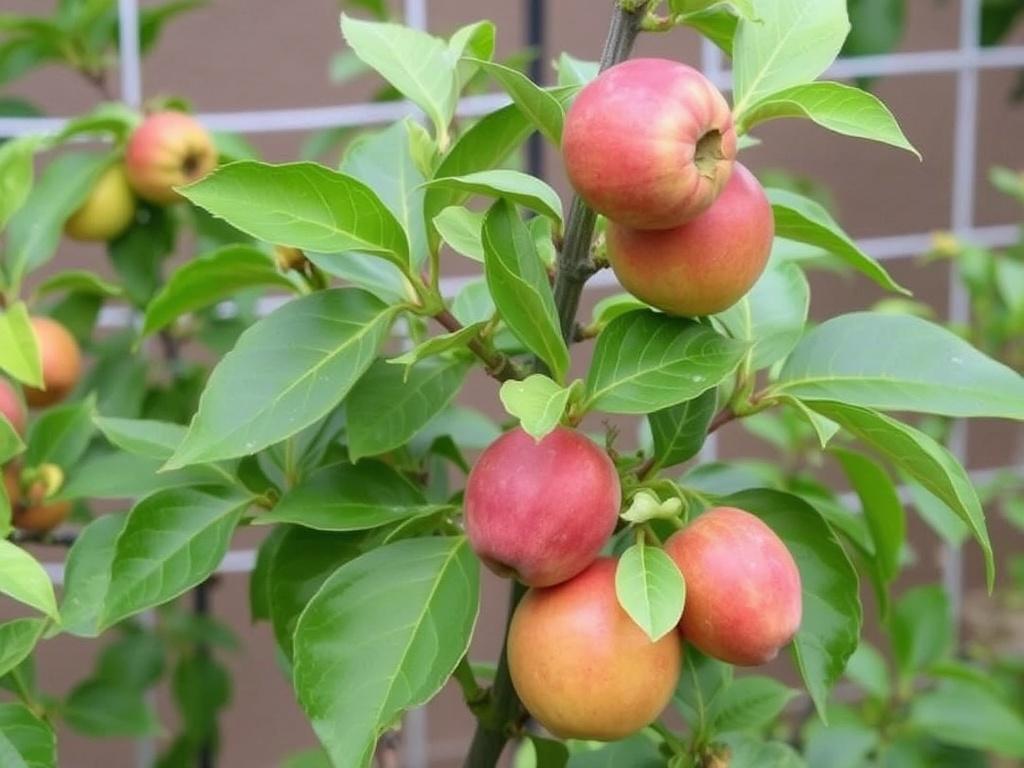
Pruning is the magic that keeps dwarf trees manageable and productive. It directs energy into fruiting wood, controls size, and allows you to shape the tree for space or aesthetics. For small spaces, two techniques shine: espaliers and cordons.
- Espaliers: Training the tree to grow flat against a wall or fence in a two-dimensional pattern. Ideal for narrow spaces and decorative fruit walls.
- Cordons: Single-stemmed training at an angle (usually 45 degrees) with short fruiting spurs—great for narrow borders.
General pruning rules:
- Prune in late winter while the tree is dormant, removing dead, crossing, or crowded branches.
- In the first 2–3 years, focus on establishing a strong scaffold structure and balancing growth.
- After fruiting, do light summer pruning to keep the shape and encourage next year’s fruiting buds.
- Thin fruit when too many form on a branch; this improves size and quality.
Seasonal pruning timeline (simple)
| Season | Action | Why |
|---|---|---|
| Late winter (dormant) | Major structural pruning, remove dead wood | Promotes healthy form and light penetration |
| Spring | Minimal pruning, training ties | Avoid heavy pruning during bud break |
| Summer | Light tips and thin crowded shoots | Controls vigor and sets buds for next year |
| Autumn | Remove diseased wood, tidy up | Prepares tree for winter |
Pollination: how to ensure fruit set in small spaces
Pollination affects whether your efforts result in juicy fruit. Some varieties are self-fertile—they set fruit from their own pollen—while others need cross-pollination from a different cultivar. Apples often need another pollinator within about 50 feet; pears sometimes require a different variety as well. Many plums, cherries, and citrus are self-fertile.
Options for small spaces:
- Choose self-fertile varieties to avoid needing a second tree.
- Graft a second compatible variety onto the same rootstock to provide cross-pollination without extra planting space.
- Place multiple small trees in adjacent pots on a balcony to sit within pollination distance.
- Encourage pollinators by planting flowers, avoiding pesticides during bloom, and providing water sources.
Pests and diseases: smart prevention in small gardens
Small-space gardening doesn’t exempt you from pests and diseases, but the scale makes control manageable. Common problems include aphids, scale, mites, fungal diseases (like powdery mildew), and codling moths or fruit flies. Organic and integrated pest management (IPM) techniques work well.
Prevention is key:
- Start with healthy trees and clean tools.
- Promote biodiversity—flowering herbs and native plants attract beneficial insects.
- Remove fallen fruit and diseased branches promptly to reduce overwintering pests.
- Use physical barriers like netting to exclude birds and large pests.
- Apply horticultural oil for scale, neem or insecticidal soap for aphids, and pheromone traps for some pests.
If disease appears, identify it and treat specifically. Broad-spectrum sprays can harm beneficial insects; targeted, minimal treatments and cultural changes often solve the problem.
Harvesting, storing, and preserving your small-space bounty
Knowing when to pick fruit is part science, part feel. For many fruits, color and a slight pull from the stem tell you it’s ripe; taste-testing small amounts is often the best indicator. Harvest carefully to avoid bruising, and process quickly for bottles, jams, or drying if you have more than you can eat fresh.
Preservation methods well-suited to small yields:
- Freezing sliced peaches, berries, or prepared citrus zest.
- Making jams, marmalades, and preserves—perfect for small-batch fruit.
- Drying fruits like figs and apples for long-term storage.
- Fermenting or making cider and liqueurs with surplus apples or stone fruit.
Creative placement ideas for dwarf fruit trees
Small-space fruit trees can be both practical and decorative. Consider these ideas:
- Espalier apples or pears along a sunny wall—beautiful and space-saving.
- Place a dwarf citrus in a terracotta pot and wheel it indoors during winter for Mediterranean charm.
- Create a container orchard on a balcony—three to five different dwarf trees can produce varied harvests.
- Use fruit trees as living privacy screens or focal points in courtyard gardens.
- Combine ornamental and edible: flowering peaches or nectarines add spring interest while fruiting later.
Container versus in-ground: pros and cons
| Aspect | Container | In-ground |
|---|---|---|
| Mobility | High—move for sun, shelter, or design | Low—you pick the permanent spot |
| Watering needs | More frequent | Less frequent |
| Root space | Limited—may require root pruning | Expansive—supports bigger growth |
| Winter protection | Easier to move indoors for frost protection | Requires site selection for hardiness |
| Yield | Smaller per tree | Potentially larger |
Maintenance schedule and expected lifespan
Dwarf trees are easier to maintain but still need a seasonal rhythm:
- Spring: Feed, check for pests, tie training wires, remove any winter damage.
- Summer: Water regularly, thin fruit, light pruning to manage size.
- Autumn: Harvest, remove fallen fruit, apply winter protection if needed.
- Winter: Major pruning, structural corrections, repair ties.
Lifespan varies by species and care: dwarfed apples and pears can live decades with good care; container trees may need refreshment or replacement after 8–15 years depending on root space and vigor.
Where to buy and what to look for
Buy trees from reputable nurseries. Decide between bare-root (often cheaper and good for planting in early spring) or container-grown (available year-round and easier to handle). When inspecting a tree, look for:
- Healthy, undamaged bark and buds
- A strong graft union and straight trunk
- No signs of disease or insect infestation
- Clear label information about rootstock and variety
Don’t be shy about asking questions: which rootstock was used, what is the expected mature size, and how hardy is the tree in your climate.
Step-by-step seasonal timeline for a small-space orchard (first 3 years)
- Year 1 (Planting year): Plant in spring, stake the tree, water regularly, apply a slow-release fertilizer in late spring, and avoid heavy pruning except for shaping.
- Year 2 (Establishment): Continue regular watering and feeding; start light structural pruning in late winter to create scaffolds; train branches if espaliering or cordoning.
- Year 3 (First good harvests): Expect your first meaningful yields on many dwarf varieties; focus on fruit thinning, disease control, and incremental pruning to maintain size.
Practical tips from small-space growers
- Label everything—especially if you have multiple varieties in pots; it’s easy to lose track.
- Rotate container positions to even out sun exposure and prevent one-sided growth.
- Use reflective surfaces or light-colored walls to boost light in shadier courtyards.
- Keep fertilizer moderate—too much nitrogen encourages leaf growth at the expense of fruiting.
- Enjoy the process—small trees reward experimentation and are forgiving of early mistakes.
Inspiration: small-space success stories
Imagine a rooftop terrace with three large pots: a dwarf apple trained to an espalier against a low wall, a Meyer lemon in a stout resin pot moved indoors in winter, and a fig in a wooden container that was pruned back and now yields a bowl of figs each summer. Or picture a narrow alley where cordon apples line the wall, creating a living tapestry that produces crisp, homegrown fruit while still fitting in the tightest city lot. Small-space fruit gardening is as much about design as about food—your trees can be sculptural, fragrant, and productive.
Conclusion
Dwarf fruit trees are a joyful and practical way to bring fresh fruit into small spaces, from balconies and courtyards to narrow gardens and rooftops. With attention to variety selection, rootstock, planting technique, pruning, and pollination, you can create a compact orchard that fits your life and flourishes with manageable maintenance. Start small, pick a few compatible varieties, and enjoy the surprise of fresh fruit harvested right outside your door—little trees giving big rewards.


